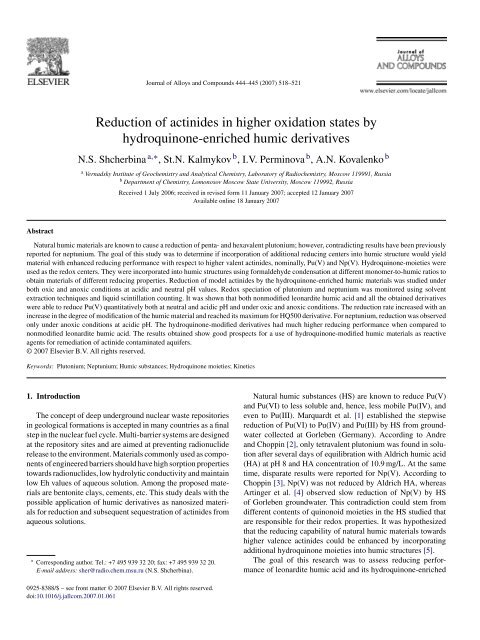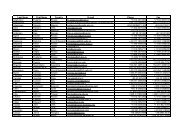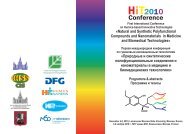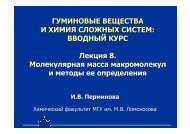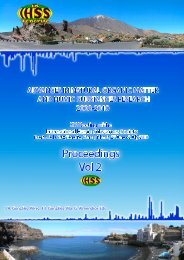Reduction of actinides in higher oxidation states by hydroquinone ...
Reduction of actinides in higher oxidation states by hydroquinone ...
Reduction of actinides in higher oxidation states by hydroquinone ...
Create successful ePaper yourself
Turn your PDF publications into a flip-book with our unique Google optimized e-Paper software.
Journal <strong>of</strong> Alloys and Compounds 444–445 (2007) 518–521<br />
<strong>Reduction</strong> <strong>of</strong> <strong>act<strong>in</strong>ides</strong> <strong>in</strong> <strong>higher</strong> <strong>oxidation</strong> <strong>states</strong> <strong>by</strong><br />
hydroqu<strong>in</strong>one-enriched humic derivatives<br />
N.S. Shcherb<strong>in</strong>a a,∗ , St.N. Kalmykov b , I.V. Perm<strong>in</strong>ova b , A.N. Kovalenko b<br />
a Vernadsky Institute <strong>of</strong> Geochemistry and Analytical Chemistry, Laboratory <strong>of</strong> Radiochemistry, Moscow 119991, Russia<br />
b Department <strong>of</strong> Chemistry, Lomonosov Moscow State University, Moscow 119992, Russia<br />
Received 1 July 2006; received <strong>in</strong> revised form 11 January 2007; accepted 12 January 2007<br />
Available onl<strong>in</strong>e 18 January 2007<br />
Abstract<br />
Natural humic materials are known to cause a reduction <strong>of</strong> penta- and hexavalent plutonium; however, contradict<strong>in</strong>g results have been previously<br />
reported for neptunium. The goal <strong>of</strong> this study was to determ<strong>in</strong>e if <strong>in</strong>corporation <strong>of</strong> additional reduc<strong>in</strong>g centers <strong>in</strong>to humic structure would yield<br />
material with enhanced reduc<strong>in</strong>g performance with respect to <strong>higher</strong> valent <strong>act<strong>in</strong>ides</strong>, nom<strong>in</strong>ally, Pu(V) and Np(V). Hydroqu<strong>in</strong>one-moieties were<br />
used as the redox centers. They were <strong>in</strong>corporated <strong>in</strong>to humic structures us<strong>in</strong>g formaldehyde condensation at different monomer-to-humic ratios to<br />
obta<strong>in</strong> materials <strong>of</strong> different reduc<strong>in</strong>g properties. <strong>Reduction</strong> <strong>of</strong> model <strong>act<strong>in</strong>ides</strong> <strong>by</strong> the hydroqu<strong>in</strong>one-enriched humic materials was studied under<br />
both oxic and anoxic conditions at acidic and neutral pH values. Redox speciation <strong>of</strong> plutonium and neptunium was monitored us<strong>in</strong>g solvent<br />
extraction techniques and liquid sc<strong>in</strong>tillation count<strong>in</strong>g. It was shown that both nonmodified leonardite humic acid and all the obta<strong>in</strong>ed derivatives<br />
were able to reduce Pu(V) quantitatively both at neutral and acidic pH and under oxic and anoxic conditions. The reduction rate <strong>in</strong>creased with an<br />
<strong>in</strong>crease <strong>in</strong> the degree <strong>of</strong> modification <strong>of</strong> the humic material and reached its maximum for HQ500 derivative. For neptunium, reduction was observed<br />
only under anoxic conditions at acidic pH. The hydroqu<strong>in</strong>one-modified derivatives had much <strong>higher</strong> reduc<strong>in</strong>g performance when compared to<br />
nonmodified leonardite humic acid. The results obta<strong>in</strong>ed show good prospects for a use <strong>of</strong> hydroqu<strong>in</strong>one-modified humic materials as reactive<br />
agents for remediation <strong>of</strong> act<strong>in</strong>ide contam<strong>in</strong>ated aquifers.<br />
© 2007 Elsevier B.V. All rights reserved.<br />
Keywords: Plutonium; Neptunium; Humic substances; Hydroqu<strong>in</strong>one moieties; K<strong>in</strong>etics<br />
1. Introduction<br />
The concept <strong>of</strong> deep underground nuclear waste repositories<br />
<strong>in</strong> geological formations is accepted <strong>in</strong> many countries as a f<strong>in</strong>al<br />
step <strong>in</strong> the nuclear fuel cycle. Multi-barrier systems are designed<br />
at the repository sites and are aimed at prevent<strong>in</strong>g radionuclide<br />
release to the environment. Materials commonly used as components<br />
<strong>of</strong> eng<strong>in</strong>eered barriers should have high sorption properties<br />
towards radionuclides, low hydrolytic conductivity and ma<strong>in</strong>ta<strong>in</strong><br />
low Eh values <strong>of</strong> aqueous solution. Among the proposed materials<br />
are bentonite clays, cements, etc. This study deals with the<br />
possible application <strong>of</strong> humic derivatives as nanosized materials<br />
for reduction and subsequent sequestration <strong>of</strong> <strong>act<strong>in</strong>ides</strong> from<br />
aqueous solutions.<br />
∗ Correspond<strong>in</strong>g author. Tel.: +7 495 939 32 20; fax: +7 495 939 32 20.<br />
E-mail address: sher@radio.chem.msu.ru (N.S. Shcherb<strong>in</strong>a).<br />
Natural humic substances (HS) are known to reduce Pu(V)<br />
and Pu(VI) to less soluble and, hence, less mobile Pu(IV), and<br />
even to Pu(III). Marquardt et al. [1] established the stepwise<br />
reduction <strong>of</strong> Pu(VI) to Pu(IV) and Pu(III) <strong>by</strong> HS from groundwater<br />
collected at Gorleben (Germany). Accord<strong>in</strong>g to Andre<br />
and Chopp<strong>in</strong> [2], only tetravalent plutonium was found <strong>in</strong> solution<br />
after several days <strong>of</strong> equilibration with Aldrich humic acid<br />
(HA) at pH 8 and HA concentration <strong>of</strong> 10.9 mg/L. At the same<br />
time, disparate results were reported for Np(V). Accord<strong>in</strong>g to<br />
Chopp<strong>in</strong> [3], Np(V) was not reduced <strong>by</strong> Aldrich HA, whereas<br />
Art<strong>in</strong>ger et al. [4] observed slow reduction <strong>of</strong> Np(V) <strong>by</strong> HS<br />
<strong>of</strong> Gorleben groundwater. This contradiction could stem from<br />
different contents <strong>of</strong> qu<strong>in</strong>onoid moieties <strong>in</strong> the HS studied that<br />
are responsible for their redox properties. It was hypothesized<br />
that the reduc<strong>in</strong>g capability <strong>of</strong> natural humic materials towards<br />
<strong>higher</strong> valence <strong>act<strong>in</strong>ides</strong> could be enhanced <strong>by</strong> <strong>in</strong>corporat<strong>in</strong>g<br />
additional hydroqu<strong>in</strong>one moieties <strong>in</strong>to humic structures [5].<br />
The goal <strong>of</strong> this research was to assess reduc<strong>in</strong>g performance<br />
<strong>of</strong> leonardite humic acid and its hydroqu<strong>in</strong>one-enriched<br />
0925-8388/$ – see front matter © 2007 Elsevier B.V. All rights reserved.<br />
doi:10.1016/j.jallcom.2007.01.061
Table 1<br />
Description and properties <strong>of</strong> humic derivatives used <strong>in</strong> this study<br />
N.S. Shcherb<strong>in</strong>a et al. / Journal <strong>of</strong> Alloys and Compounds 444–445 (2007) 518–521 519<br />
Sample Description COOH a (mmol/g) ArOH b (mmol/g) <strong>Reduction</strong> capacity (mmol/g)<br />
CHP Leonardite HA 4.2 ± 0.2 1.1 0.6 ± 0.1<br />
HQ100 HQ:CHP ratio <strong>of</strong> 100:1000 mg 4.3 ± 0.3 4.0 1.2 ± 0.2<br />
HQ250 HQ:CHP ratio <strong>of</strong> 250:1000 mg 3.6 ± 0.1 4.4 2.9 ± 0.1<br />
HQ500 HQ:CHP ratio <strong>of</strong> 500:1000 mg 3.1 ± 0.2 4.3 4.0 ± 0.1<br />
a As determ<strong>in</strong>ed <strong>by</strong> calcium acetate technique.<br />
b Calculated as a difference between total acidity and<br />
COOH content.<br />
derivatives with respect to Pu(V) and Np(V). The capability <strong>of</strong><br />
humic materials to reduce <strong>act<strong>in</strong>ides</strong> <strong>in</strong> <strong>higher</strong> <strong>oxidation</strong> <strong>states</strong><br />
<strong>of</strong>fers them quite useful as components for <strong>in</strong> situ remediation<br />
technologies and <strong>in</strong> the design <strong>of</strong> permeable reactive barriers at<br />
the nuclear waste sites.<br />
2. Experimental<br />
2.1. Synthesis and characterization <strong>of</strong> HS<br />
The qu<strong>in</strong>onoid-enriched humic derivatives were obta<strong>in</strong>ed as described <strong>by</strong><br />
Perm<strong>in</strong>ova et al. [5] us<strong>in</strong>g the reaction <strong>of</strong> formaldehyde copolycondensation<br />
between leonardite humic acid (CHP) and hydroqu<strong>in</strong>one. Leonardite humic acids<br />
were isolated from commercially available potassium humate (Powhumus TM )<br />
produced <strong>by</strong> Hum<strong>in</strong>tech Ltd., Germany. For this purpose, a known weight <strong>of</strong><br />
potassium humate was dissolved <strong>in</strong> distilled water and centrifuged to separate<br />
and discard any <strong>in</strong>soluble m<strong>in</strong>eral components. The supernatant was then<br />
acidified to pH 2 with concentrated HCl and centrifuged. The precipitate <strong>of</strong><br />
humic acids (HA) was collected, washed with distilled water, desalted us<strong>in</strong>g<br />
electrodialysis, evaporated at 60 ◦ C, and stored <strong>in</strong> a desiccator over P 2 O 5 . The<br />
material obta<strong>in</strong>ed was used for condensation with hydroqu<strong>in</strong>one at different<br />
monomer-to-humic ratios: 100, 250 and 500 mg <strong>of</strong> hydroqu<strong>in</strong>one per 1 g <strong>of</strong><br />
CHP. The correspond<strong>in</strong>g derivatives were designated as HQ100, HQ250 and<br />
HQ500, respectively. The degree <strong>of</strong> modification <strong>of</strong> the derivatives obta<strong>in</strong>ed<br />
was determ<strong>in</strong>ed us<strong>in</strong>g calcium acetate and barium hydroxide techniques and the<br />
reduction capacity <strong>of</strong> the derivatives was determ<strong>in</strong>ed us<strong>in</strong>g ferricyanide as oxidiz<strong>in</strong>g<br />
agent as described <strong>in</strong> [5]. List and properties <strong>of</strong> the derivatives obta<strong>in</strong>ed<br />
are given <strong>in</strong> Table 1.<br />
2.2. K<strong>in</strong>etics <strong>of</strong> Pu(V) and Np(V) reduction <strong>by</strong><br />
hydroqu<strong>in</strong>one-enriched humic derivatives<br />
Pu(V) and Np(V) reduction k<strong>in</strong>etics was studied us<strong>in</strong>g 238 Pu, 239 Pu, 242 Pu<br />
and 237 Np. Plutonium <strong>in</strong> its pentavalent form was prepared <strong>by</strong> the procedure<br />
described <strong>in</strong> [6]. Radioactivity count<strong>in</strong>g was performed us<strong>in</strong>g semiconductor<br />
alpha-spectrometry and liquid sc<strong>in</strong>tillation count<strong>in</strong>g. The reduction <strong>of</strong> Pu(V) <strong>by</strong><br />
humic derivatives at tracer level concentrations (2.3×10 −9 M) and HS concentrations<br />
<strong>of</strong> 10 mg/L was studied <strong>by</strong> solvent extraction technique as described<br />
<strong>by</strong> Morgenstern and Chopp<strong>in</strong> [7]. Pu(IV) was separated <strong>by</strong> 1-(2-thenoyl)-<br />
3,3,3-trifluoroacetone (TTA) <strong>in</strong> toluene. Pu(III) was determ<strong>in</strong>ed us<strong>in</strong>g the same<br />
procedure after its <strong>oxidation</strong> to Pu(IV) <strong>by</strong> addition <strong>of</strong> small amount <strong>of</strong> KBrO 3 .<br />
Pu(III) concentration was calculated as a difference between plutonium extracted<br />
with and without addition <strong>of</strong> KBrO 3 [8]. Redox speciation <strong>of</strong> Np(V) was studied<br />
us<strong>in</strong>g extraction with di-(2-ethylhexyl)-phosphoric acid (HDEHP, Aldrich),<br />
which extracts Np(IV) from 1 M HCl solution [7]. Experiments were carried out<br />
under both oxic (ambient atmospheric conditions) and anoxic (Ar atmosphere)<br />
conditions.<br />
Experiments under anoxic conditions were performed <strong>in</strong> foiled plastic 50 ml<br />
vials to prevent photolysis <strong>of</strong> humic derivatives and <strong>in</strong> a glove box filled with N 2<br />
or Ar to keep oxygen-free conditions to prevent hydroqu<strong>in</strong>one fragments from<br />
<strong>oxidation</strong> <strong>by</strong> air oxygen. The ionic strength was close to zero and constant pH<br />
values <strong>of</strong> 4.5 ± 0.2 and pH 7.5 ± 0.2 were ma<strong>in</strong>ta<strong>in</strong>ed without buffer solutions.<br />
The <strong>oxidation</strong> <strong>states</strong> <strong>of</strong> Pu were monitored periodically <strong>by</strong> extraction <strong>of</strong> 1.5 mL<br />
aliquots <strong>of</strong> solution.<br />
3. Results and discussion<br />
The properties <strong>of</strong> humic materials used <strong>in</strong> this study<br />
are listed <strong>in</strong> Table 1. The reduction capacity <strong>in</strong>creased<br />
along with an <strong>in</strong>crease <strong>in</strong> hydroqu<strong>in</strong>one content so that the<br />
derivatives could be put <strong>in</strong> the follow<strong>in</strong>g ascend<strong>in</strong>g order:<br />
CHP < HQ100 < HQ250 < HQ500.<br />
3.1. Pu(V) reduction <strong>by</strong> humic derivatives<br />
The k<strong>in</strong>etics <strong>of</strong> Pu(V) reduction <strong>in</strong> the presence <strong>of</strong> parent<br />
leonardite HA under oxic and anoxic conditions is shown <strong>in</strong><br />
Fig. 1. The reduction rate under anoxic conditions was significantly<br />
<strong>higher</strong> compared to oxic conditions. Under anoxic<br />
conditions, almost complete Pu(V) reduction occurred with<strong>in</strong><br />
3–4 h, while under atmospheric conditions, it took 120 h for<br />
complete Pu(V) reduction. Much slower reduction k<strong>in</strong>etics <strong>of</strong><br />
Pu(V) was evidently caused <strong>by</strong> competitive <strong>in</strong>teraction <strong>of</strong> redox<br />
centers <strong>of</strong> CHP with air dissolved <strong>in</strong> the test solution. To avoid<br />
the <strong>in</strong>fluence <strong>of</strong> oxygen, all further experiments were carried out<br />
under anoxic conditions <strong>in</strong> a glove box filled with argon gas.<br />
The k<strong>in</strong>etics <strong>of</strong> Pu(V) reduction <strong>in</strong> the presence <strong>of</strong> different<br />
hydroqu<strong>in</strong>one-enriched derivatives under anoxic conditions<br />
at pH 7.5 is shown <strong>in</strong> Fig. 2. As can be seen, complete Pu(V)<br />
reduction was observed <strong>in</strong> the presence <strong>of</strong> all derivatives. However,<br />
the rate <strong>of</strong> reduction <strong>in</strong>creased along with an <strong>in</strong>crease <strong>in</strong><br />
the degree <strong>of</strong> modification <strong>of</strong> the derivative tested. It <strong>in</strong>creased<br />
<strong>in</strong> the order <strong>of</strong> CHP < HQ100 ≤ HQ250 < HQ500, which corre-<br />
Fig. 1. Pu(V) reduction <strong>by</strong> leonardite HA (CHP) under oxic and anoxic conditions:<br />
C tot (Pu) = 7.17×10 −9 M, C tot (HS) = 10 mg/L, pH 4.7 ± 0.2, I =0M.
520 N.S. Shcherb<strong>in</strong>a et al. / Journal <strong>of</strong> Alloys and Compounds 444–445 (2007) 518–521<br />
Table 2<br />
Np(V) reduction <strong>by</strong> hydroqu<strong>in</strong>one-enriched HS under anoxic conditions;<br />
C tot (Np) = 1.44×10 −6 M, C tot (HS) = 10 mg/L, pH 4.5 ± 0.2, I =0M<br />
Sample<br />
Np(V) content (percent <strong>of</strong> <strong>in</strong>itial) <strong>in</strong> reaction<br />
mixture at two different exposure times<br />
2 h (%) 144 h (%)<br />
CHP 98.9 ± 2.7 67.3 ± 3.3<br />
HQ100 96.8 ± 2.8 55.3 ± 3.6<br />
HQ250 80.2 ± 2.7 39.6 ± 3.8<br />
HQ500 95.7 ± 2.7
N.S. Shcherb<strong>in</strong>a et al. / Journal <strong>of</strong> Alloys and Compounds 444–445 (2007) 518–521 521<br />
materials with enhanced redox properties. This opens a way<br />
for broad application <strong>of</strong> these reactive humic materials <strong>in</strong> the<br />
practice <strong>of</strong> remediation technologies.<br />
Acknowledgements<br />
This work was supported <strong>by</strong> NATO-CLG (grant 980508)<br />
and <strong>by</strong> jo<strong>in</strong>t research program between US DOE and Russian<br />
Academy <strong>of</strong> Sciences (project RUC2-20006 MO-04).<br />
References<br />
[1] C.M. Marquardt, A. Seibert, R. Art<strong>in</strong>ger, M.A. Denecke, B. Kuczewski, D.<br />
Schild, Th. Fanghanel, Radiochim. Acta 92 (2004) 617–623.<br />
[2] C. Andre, G.R. Chopp<strong>in</strong>, Radiochim. Acta 88 (2000) 613–616.<br />
[3] G.R. Chopp<strong>in</strong>, Proceed<strong>in</strong>gs <strong>of</strong> NEA Workshop, Bad Zurzach, Switzerland,<br />
1994, pp. 75–79.<br />
[4] R. Art<strong>in</strong>ger, C.M. Marquardt, J.I. Kim, Radiochim. Acta 88 (2000)<br />
609–612.<br />
[5] I.V. Perm<strong>in</strong>ova, A.N. Kovalenko, P. Schmitt-Koppl<strong>in</strong>, K. Hatfield, N.<br />
Hertkorn, E.Y. Belyaeva, V.S. Petrosyan, Environ. Sci. Technol. 39 (21)<br />
(2005) 8518–8524.<br />
[6] M.S. Milyukova, N.I. Gusev, I.G. Sentyur<strong>in</strong>, Analytical Chemistry <strong>of</strong> Elements,<br />
“Plutonium” Nauka Publishers, Moscow, 1965, pp. 157–160.<br />
[7] A. Morgenstern, G.R. Chopp<strong>in</strong>, Radiochim. Acta 90 (2002) 69–74.<br />
[8] D. Rai, Y.A. Gor<strong>by</strong>, J.K. Fredrickson, D.A. Moore, M. Yui, J. Solution<br />
Chem. 6 (2002) 433–452.<br />
[9] L. Rao, G.R. Chopp<strong>in</strong>, Radiochim. Acta 69 (1995) 87–95.<br />
[10] C.T. Garten Jr., D.M. Ham<strong>by</strong>, R.G. Schreckhise, Sci. Total Environ. 255<br />
(2000) 55–73.<br />
[11] L. Liang, G.R. Mol<strong>in</strong>e, W. Kamolpornwijit, O.R. West, J. Contam. Hydrol.<br />
80 (2005) 71–91.


